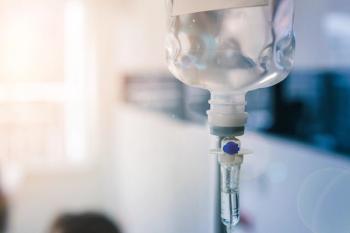
Study Reports Dietary Recommendation for Managing GLP-1-Related Gastrointestinal Adverse Events
Key Takeaways
- GLP-1 receptor agonists facilitate weight loss in non-diabetic adults, with gastrointestinal adverse events being the most common safety concern.
- Dietary recommendations aim to mitigate gastrointestinal symptoms, focusing on food consistency, meal composition, and lifestyle factors.
Recommendations help influence the rate of gastric emptying, improve compliance, and prevent interruption of weight loss for patients.
In a study published in Diabetes, Metabolic Syndrome, and Obesity, investigators compiled dietary recommendations that help influence the rate of gastric emptying, improve compliance, and prevent interruption of weight loss for patients who are being treated with glucagon-like peptide-1 (GLP-1) receptor agonists.1
According to the World Health Organization (WHO), approximately 43% of adults 18 years and older were living with overweight in 2022 worldwide, and 16% were living with obesity. WHO defines overweight as a body mass index (BMI) of greater than or equal to 25 and obesity as a BMI greater than or equal to 30. Obesity has been established as a multifactorial disease, including obesogenic environments, psycho-social factors, and genetic variants.2
Recently, a new analysis published in Annals of Internal Medicine shows GLP-1 receptor agonists and co-agonists facilitate weight loss for adults with overweight or obesity and without diabetes. The safety concerns reported by investigators were generally gastrointestinal, which supports previous safety findings for GLP-1 medication.3
The analysis showed that tirzepatide showed weight loss of up to 17.8%, semaglutide showed up to 13.9%, and liraglutide showed up to 5.8%. Adverse events (AEs) were frequent, with the majority being gastrointestinal-related, such as nausea, vomiting, diarrhea, and constipation. Investigators also found that AEs requiring discontinuation and serious AEs were rare.3
In the current study, investigators set out to compose dietary advice to help mitigate gastrointestinal symptoms, including food consistency, viscosity, meal composition, and lifestyle factors. The study authors reported that studies were included if they focused on individual treated with GLP-1s or the physiology of gastric emptying and were published within the last 20 years. After the initial search, 2 authors assessed the titles and abstracts of the relevant studies, then reviewed the full text. Any disagreements were solved by a third author.1
According to the study authors, the management of gastrointestinal AEs is essential for treatment adherence, and prescribers will also adjust the dose for the management of the AEs. However, the authors note that AEs often occur in patients with inadequate diet, and so far, there is no specific guidance on caloric restriction and type of foods that can help or harm GLP-1 treatment.1
Investigators established an adapted version of the Harvard Healthy Plate, which includes guidance on cereals, protein, fats and vegetables, as tools to manage gastrointestinal symptoms. The tool created does not specify quantities as the authors believe that the guidance should be tailored specifically to the individual’s needs and goals. Further, since the AEs often occur in the evening, the findings offer advice for dinner.1
The findings suggest that complex carbohydrates, including pasta, bread, and crackers, could help to manage the impact of fiber and glucose on gastric emptying, and the food should be moderate to support digestion. Patients should avoid whole grain products and foods that were high in simple sugars. Protein such as red meats and processed cold cuts can delay gastric emptying, but low-fat protein sources such as white meats and blue fish are recommended. Moderate temperature, fresh cheese is recommended, but mature cheeses, which contain higher fat content, should be avoided. Legumes should be avoided due to their high fiber content and are best consumed during lunch.1
For fats, investigators recommend moderation as fats are essential for overall health, but extra virgin olive oil is preferred because of health benefits, including anti-inflammatory and cardioprotective benefits. Fiber can slow gastric emptying, so low-fiber vegetables are recommended as well as an appropriate portion size. The authors suggest portion sizes should be kept to maintain digestive comfort but should be personalized for each patient.1
Additionally, dietary recommendations include consuming small, frequent meals, using simple cooking methods, avoiding complex dishes, spicy foods, and alcohol, staying well-hydrated, choosing fruits as a snack, and avoiding lying down, and engaging vigorous activity post-meal.1
REFERENCES
1. Gentinetta S, Sottotetti F, Manuelli M, Cena H. Dietary Recommendations for the Management of Gastrointestinal Symptoms in Patients Treated with GLP-1 Receptor Agonist. Diabetes Metab Syndr Obes. 2024;17:4817-4824. Published 2024 Dec 19. doi:10.2147/DMSO.S494919
2. CDC. Obesity and overweight. March 1, 2024. Accessed January 9, 2025. https://www.who.int/news-room/fact-sheets/detail/obesity-and-overweight
3. Moiz A, Filion KB, Toutounchi H, et al. Efficacy and Safety of Glucagon-Like Peptide-1 Receptor Agonists for Weight Loss Among Adults Without Diabetes: A Systematic Review of Randomized Controlled Trials. Ann Intern Med. Published online January 7, 2025. doi:10.7326/ANNALS-24-01590
Newsletter
Stay informed on drug updates, treatment guidelines, and pharmacy practice trends—subscribe to Pharmacy Times for weekly clinical insights.


















































































































































































































